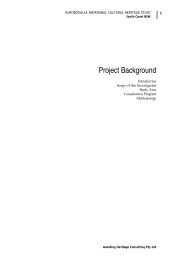Eurobodalla Integrated Water Cycle Management Strategy
Eurobodalla Integrated Water Cycle Management Strategy
Eurobodalla Integrated Water Cycle Management Strategy
Create successful ePaper yourself
Turn your PDF publications into a flip-book with our unique Google optimized e-Paper software.
iv<br />
<strong>Eurobodalla</strong> <strong>Integrated</strong> <strong>Water</strong> <strong>Cycle</strong> <strong>Management</strong> <strong>Strategy</strong><br />
How Do We Fix the Issues<br />
The need for new infrastructure can be reduced or delayed by using a variety of IWCM<br />
tools.<br />
Important components of the Shire wide scenarios are expanded demand management<br />
programs, introduction of rainwater tanks and better management or enhancement of onsite<br />
wastewater systems.<br />
Regional water supply infrastructure requirements include additional delivery capacity,<br />
water filtration and additional future water storage.<br />
Improvements can be made to the reticulated sewerage schemes and the management of<br />
on-site systems to reduce the impacts on environmental water quality.<br />
<strong>Water</strong> efficiency can be further improved through the development of a number of new<br />
water reuse schemes.<br />
The new infrastructure options can be combined with IWCM measures to produce<br />
integrated Shire-wide scenarios to optimise social, environmental and financial outcomes.<br />
Regional <strong>Water</strong> Supply <strong>Management</strong> <strong>Strategy</strong><br />
Opportunities for Managing Regional <strong>Water</strong> Demand<br />
<strong>Eurobodalla</strong> has made significant gains in water conservation and demand reduction<br />
through the ‘user pays’ pricing policy and community awareness programs. Achieving more<br />
sustainable water use involves a multi-faceted approach. There are a variety of IWCM tools<br />
available to reduce water demands and achieve more sustainable outcomes at the regional<br />
level. Fact sheets of IWCM tools can be found in Section 4 of the report. How these can be<br />
applied for <strong>Eurobodalla</strong> is found in Section 8.1. The triple bottom line (TBL) assessment<br />
carried out on all the demand side opportunities, has bundled planning controls,<br />
unaccounted for water assessment and loss reduction program, water pricing, water<br />
conservation education program targeting outdoor watering use and non-residential water<br />
use and an active showerhead retrofit program as the main elements of a comprehensive<br />
demand management program.<br />
Opportunities for Developing the Local Supply Sources<br />
Three rainwater tank opportunities were identified as local supply sources.<br />
1. Rainwater tanks in all new developments<br />
2. Rainwater tanks in all new developments and 20% of existing developments<br />
3. Rainwater tanks in all new developments and 40% of existing developments.<br />
According to the TBL assessment, options 2 and 3 ranked as equally suitable options in<br />
terms of environmental, social and financial criteria. Whilst the option of mandating<br />
rainwater tanks in all new developments and retrofitting 40% of existing developments<br />
achieves the best environmental outcomes, it is the most expensive option in terms of<br />
community costs. <strong>Water</strong> savings through mandating rainwater tanks in all new<br />
developments plus retrofitting 20% of existing houses has been included in the integrated<br />
regional supply options. Other potential local supply source opportunities include<br />
stormwater reuse and residential greywater reuse.

















